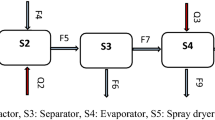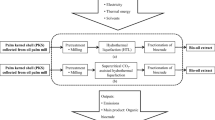Abstract
In this study, Life Cycle Assessment upon the production chain of an encapsulated olive leaves’ extract (enzymatically modified) has been applied. The chain consists of eleven processes — from the acquisition of raw material up to the production of the powder. This study’s primary goal was not only to examine the overall final environmental footprint, but also, to compare two different extraction techniques, supercritical fluid extraction (SFE) and solid–liquid extraction (SLE), in relation to their contribution to this environmental footprint. In addition, the effect of alternative conditions of these techniques was evaluated. “Hotspot” processes were detected. Literature, Gabi ts database, and Aspen simulations were the sources utilized for data acquisition. The assessment of all available impact categories for the examined scenarios was performed. According to the results, (a) all impact indicators for each scenario were low, encouraging such a product’s production; (b) the extraction yield emerged as an important parameter, defining the overall environmental footprint; (c) SLE with ethanol as solvent led to the lowest environmental footprint, encouraging, e.g., its selection in the mass production; (d) SFE technique (with cosolvent, preferably) remains a viable option for industry; and (e) Increase of yield of SFE with cosolvent technique leads to a decrease of the overall environmental footprint.








Similar content being viewed by others
References
Şahin S, Bilgin M (2018) Olive tree (Olea europaea L.) leaf as a waste by-product of table olive and olive oil industry: a review. J Sci Food Agric. https://doi.org/10.1002/jsfa.8619
Erbay Z, Icier F (2010) The importance and potential uses of olive leaves. Food Rev Intl. https://doi.org/10.1080/87559129.2010.496021
Galanakis CM (2017) Olive Mill Waste - Recent Advances for Sustainable Management. In: Galanakis CM (ed) Olive Mill Waste. Academic Press, Oxford, pp 57–78
Souilem S et al (2017) Emerging technologies for recovery of value-added components from olive leaves and their applications in food/feed industries. Food Bioprocess Technol 10(2):229–248
Özcan MM, Matthäus B (2017) A review: benefit and bioactive properties of olive (Olea europaea L.) leaves. Eur Food Res Technol. https://doi.org/10.1007/s00217-016-2726-9
Al-Rimawi F et al (2014) Formulation and evaluation of a moisturizing day cream containing olive leaves extract. Int J Dev Res 4(10):1996–2000
Le Floch F et al (1998) Supercritical fluid extraction of phenol compounds from olive leaves. Talanta. https://doi.org/10.1016/S0039-9140(97)00375-5
Silva Da, Rui PFF et al (2016) Supercritical fluid extraction of bioactive compounds. TrAC, Trends Anal Chem. https://doi.org/10.1016/j.trac.2015.11.013
Şahin S et al (2011) Investigation of oleuropein content in olive leaf extract obtained by supercritical fluid extraction and soxhlet methods. Sep Sci Technol. https://doi.org/10.1080/01496395.2011.573519
Nedovic V et al (2011) An overview of encapsulation technologies for food applications. Procedia Food Sci 1:1806–1815
Rapinel V et al (2017) Feasibility of using liquefied gas HFO-1234ze (trans-1, 3, 3, 3-tetrafluoroprop-1-ene) as an alternative to conventional solvents for solid–liquid extraction of food ingredients and natural products. LWT-Food Sci Technol. https://doi.org/10.1016/j.lwt.2017.05.027
Alvarez V et al (2017) Functional textiles for skin care by active substance encapsulation. J Text Eng Fash Technol 2(6):82
Mourtzinos I et al (2007) Encapsulation of olive leaf extract in β-cyclodextrin. J Agric Food Chem 55:8088–8094
Mohammadi A et al (2016) Nano- encapsulation of olive leaf phenolic compounds through WPC-pectin complexes and evaluating their release rate. Int J Biol Macromol. https://doi.org/10.1016/j.ijbiomac.2015.10.025
Kiritsakis K et al (2018) Valorization of olive leaves: spray drying of olive leaf extract. Waste biomass valorization. https://doi.org/10.1007/s12649-017-0023-x
Gabi, Sphera (2021) Paperclip Tutorial (Part 1), Gabi Learning Center. https://gabi.sphera.com/fileadmin/gabi/GaBi_Learning_Center_Paperclip_Tutorial_Part1.pdf
TOSCA sustainability framework (2021) Introduction to LCA. https://tosca-life.info/getting-started-guides/life-cycle-assessment/introduction-to-lca/
Karoglou M et al (2019) Towards a preservation-sustainability nexus: applying LCA to reduce the environmental footprint of modern built heritage. Sustainability 11(21):6147
Khounani Z et al (2021) Environmental life cycle assessment of different biorefinery platforms valorizing olive wastes to biofuel, phosphate salts, natural antioxidant, and an oxygenated fuel additive (triacetin). J Clean Prod. https://doi.org/10.1016/j.jclepro.2020.123916
International Olive Council (2021) World olive oil production could absorb the CO2 emissions of a city the size of Hong Kong. https://www.internationaloliveoil.org/1074-world-olive-oil-production-could-absorb-the-co2-emissions-of-a-city-the-size-of-hong-kong/
Bakshi MPS, Wadhwa M (2007) Tree leaves as complete feed for goat bucks. Small Rumin Res. https://doi.org/10.1016/j.smallrumres.2005.12.00969
Skretis, Antonios (2019) The industry of olive oil in Greece: the current conditions and prospects. Dissertation, National Technical University of Athens
Pua CK et al (2010) Optimization of drum drying processing parameters for production of jackfruit (Artocarpus heterophyllus) powder using response surface methodology. LWT- Food Sci Technol. https://doi.org/10.1016/j.lwt.2009.08.011
Henríquez C et al (2014) Kinetic modeling of phenolic compound degradation during drum-drying of apple peel by-products. J Food Eng. https://doi.org/10.1016/j.jfoodeng.2014.06.037
Tang J et al (2003) Drum drying, Encyclopaedia of Agricultural, Food, and Biological Engineering. Marcel Dekker Inc, New York, pp 211–214
Nourhène B et al (2008) Experimental and mathematical investigations of convective solar drying of four varieties of olive leaves. Food Bioprod Process. https://doi.org/10.1016/j.fbp.2007.10.001
Malik N.S.A, Bradford J.M. (2008) Recovery and stability of oleuropein and other phenolic compounds during extraction and processing of olive (Olea europaea L.) leaves, Journal of Food, Agriculture & Environment, 6, 2, 8–13
Jiangyin Baoli Machinery Manufacturing Co., Ltd (2021) Crush and Mixing Series https://www.cnboly.com/
Kruszelnicka W et al (2020) The integrated energy consumption index for energy biomass grinding technology assessment. Energies. https://doi.org/10.3390/en13061417
Carlson R et al (1998) LCI data modelling and a database design, The. Int J Life Cycle Assess 3(2):106–113
V. Koulocheris et al (2019) UMR-PRU thermodynamic model: application to natural gas processing. CAPE-OPEN 2019 Annual Meeting (Amsterdam). https://www.colan.org/wp-content/uploads/2019/10/Y19_COEU_NTUA.pdf
Lama-Muñoz A et al (2019) Extraction of oleuropein and luteolin-7-O-glucoside from olive leaves: optimization of technique and operating conditions. Food Chem. https://doi.org/10.1016/j.foodchem.2019.04.075
Cifá D et al (2018) Enhanced yield of oleuropein from olive leaves using ultrasound-assisted extraction. Food Sci Nutr. https://doi.org/10.1002/fsn3.654
Chatzikonstantinou AV et al (2019) Enzymatic conversion of oleuropein to hydroxytyrosol using immobilized β-glucosidase on porous carbon cuboids. Nanomaterials 9(8):1166
Kim K-H et al (1988) Pre-concentration of apple juice with different reverse osmosis membranes. Korean J Food Sci Technol 20(3):419
Rodriques LM et al (2020) Camu-camu bioactive compounds extraction by ecofriendly sequential processes (ultrasound assisted extraction and reverse osmosis). Ultrason Sonochem. https://doi.org/10.1016/j.ultsonch.2020.105017
Shofian NM et al (2011) Effect of freeze-drying on the antioxidant compounds and antioxidant activity of selected tropical fruits. Ιnt J Μol Sci. https://doi.org/10.3390/ijms12074678
Huang L-L et al (2009) Studies on decreasing energy consumption for a freeze-drying process of apple slices. Drying Technol. https://doi.org/10.1080/07373930902901844
Pardo JM, Leiva DA (2010) Effects of different pre-treatments on energy consumption during freeze drying of pineapple pieces. Interciencia 35(12):934–938
Drosou CG et al (2017) Encapsulation of bioactive compounds through electrospinning/electrospraying and spray drying: a comparative assessment of food-related applications. Drying Technol. https://doi.org/10.1080/07373937.2016.1162797
Adamiec J (2009) Moisture sorption characteristics of peppermint oil microencapsulated by spray drying. Drying Technol. https://doi.org/10.1080/07373930903383695
Urzúa C et al (2017) Olive leaves extract encapsulated by spray-drying in vacuum fried starch–gluten doughs. Food Bioprod Process. https://doi.org/10.1016/j.fbp.2017.10.001
M. Panagiotopoulou et al (2021) Valorisation of olive processing waste for the development of value-added products, 8th International Conference on Sustainable Solid Waste Management. http://uest.ntua.gr/thessaloniki2021/pdfs/THESSALONIKI_2021_Panagiotopoulou_et_al.pdf
Zhejiang Xing Huo Machinery & Electric Factory (2021), Circulating Pump SR/A https://www.sihiopump.com/
Carlqvist K et al (2022) Life cycle assessment for identification of critical aspects in emerging technologies for the extraction of phenolic compounds from spruce bark. J Clean Prod. https://doi.org/10.1016/j.jclepro.2021.130093
F. Saloustros et al (2019) Study of extraction of bioactive compounds from olive leaves, 12th National Scientific Conference on Chemical Engineering http://12pesxm.chemeng.ntua.gr/final_papers/PT0345.pdf
Poulogiannopoulou M. (2019) Recovery of bioactive extracts from olive leaves using supercritical CO2. Dissertation, National Technical University of Athens
Jackson S, Eivind B (2018) A comparison of the energy consumption for CO2 compression process alternatives. IOP Conf Ser Earth Environ Sci. https://doi.org/10.1088/1755-1315/167/1/012031
Ganorkar P et al (2012) Reverse osmosis for fruit juice concentration- a review. Res Rev A J Food Sci Technol 1:23–36
Gude VG (2011) Energy consumption and recovery in reverse osmosis. Desalin Water Treat. https://doi.org/10.5004/dwt.2011.2534
Butt FH et al (1997) Hollow fine fiber vs. spiral-wound reverse osmosis desalination membranes part 2: membrane autopsy. Desalination. https://doi.org/10.1016/S0011-9164(97)00054-409.1
Tang XC, Michael JP (2004) Design of freeze-drying processes for pharmaceuticals: practical advice. Pharm Res. https://doi.org/10.1023/B:PHAM.0000016234.73023.75
Gwee YL et al (2020) Techno-economic and life-cycle assessment of volatile oil extracted from Aquilaria sinensis using supercritical carbon dioxide. J CO2 Util. https://doi.org/10.1016/j.jcou.2020.01.002
Acknowledgements
The authors are grateful to Thermodynamics & Transport Phenomena Laboratory of National Technical University of Athens for the supercritical fluid extraction experiments of the olive leaves and to Biotechnology Laboratory of University of Ioannina for the data provision upon the bio-process.
Funding
This research has been co‐financed by the European regional Development Fund of the European Union and Greek national funds through the Operational Program Competitiveness, Entrepreneurship and Innovation, under the call RESEARCH – CREATE – INNOVATE (project code: T1EDK-01716).
Author information
Authors and Affiliations
Contributions
C.Boukouvalas: conceptualization, research, writing, calculations, supervision, K.Kritsotakis: conceptualization, research, writing, calculations; M.Panagiotopoulou: writing, experimental; S.Papadaki: writing, experimental; M.Krokida: project administration.
Corresponding author
Ethics declarations
Conflict of interest
The authors declare no competing interests.
Additional information
Publisher's note
Springer Nature remains neutral with regard to jurisdictional claims in published maps and institutional affiliations.
Rights and permissions
About this article
Cite this article
Kritsotakis, K., Boukouvalas, C., Panagiotopoulou, M. et al. Life Cycle Assessment (LCA) upon the production chain of a powder containing modified olive leaves’ extract. Biomass Conv. Bioref. 12, 4503–4518 (2022). https://doi.org/10.1007/s13399-022-02495-0
Received:
Revised:
Accepted:
Published:
Issue Date:
DOI: https://doi.org/10.1007/s13399-022-02495-0




